Abstract
Amebae belonging to the order Leptomyxida are regarded as innocuous soil organisms incapable of infecting mammals. We report here the isolation of a leptomyxid ameba from the brain of a pregnant baboon (Papio sphinx) that died of meningoencephalitis at the San Diego Zoo Wild Animal Park. By using rabbit anti-leptomyxid serum in the immunofluorescence assay, we have identified the leptomyxid ameba in the brain sections of a number of human encephalitic cases from around the world as well as a few cases of meningoencephalitis in animals in the United States, which suggests that the leptomyxid amebae are potential etiologic agents of fatal meningoencephalitis in humans and animals.
Full text
PDF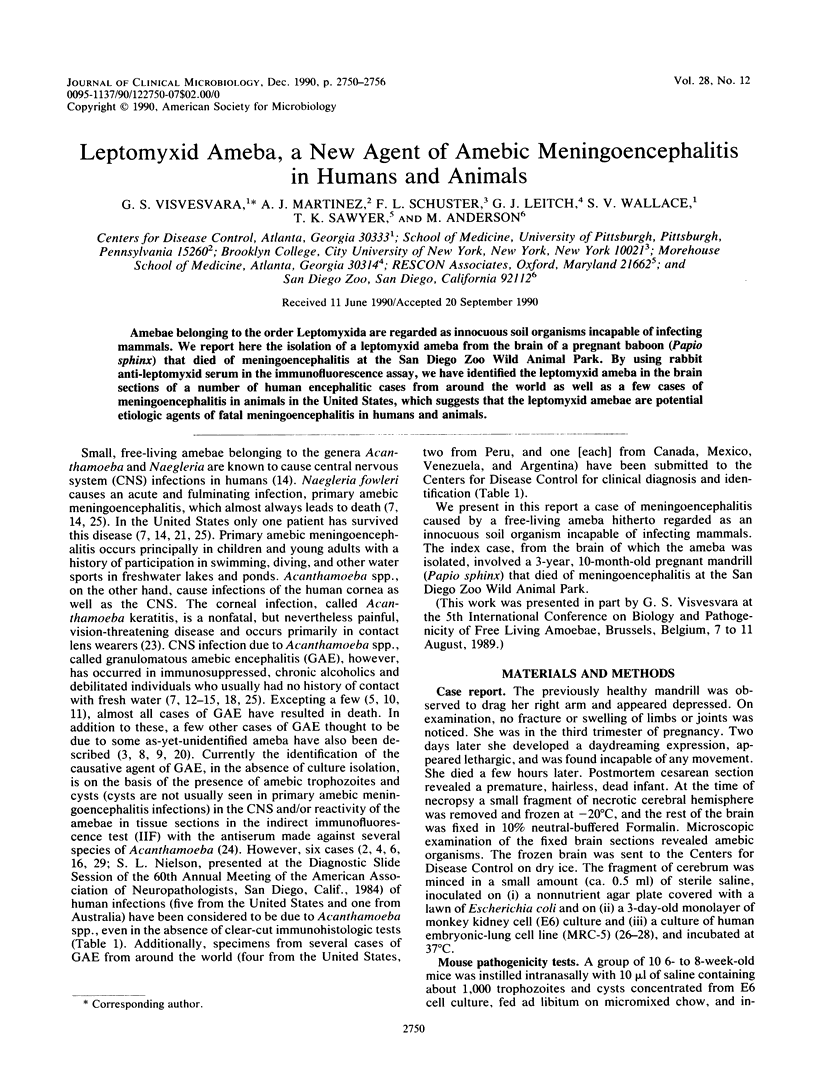
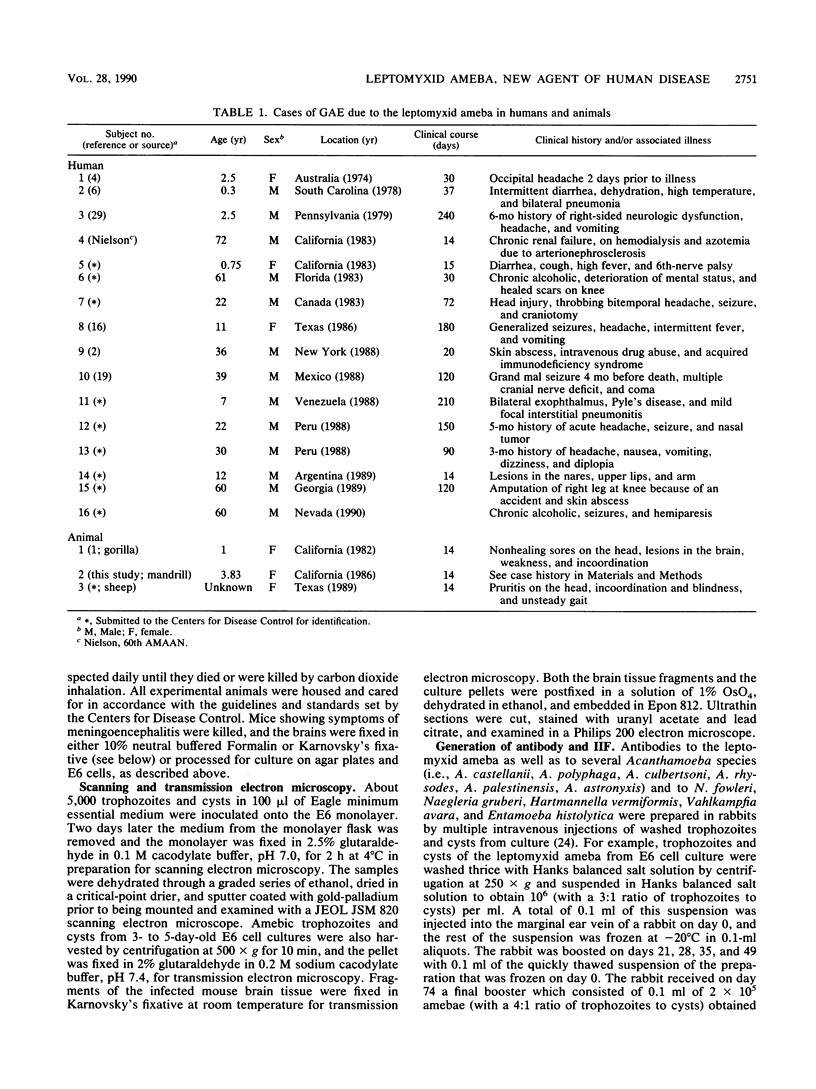
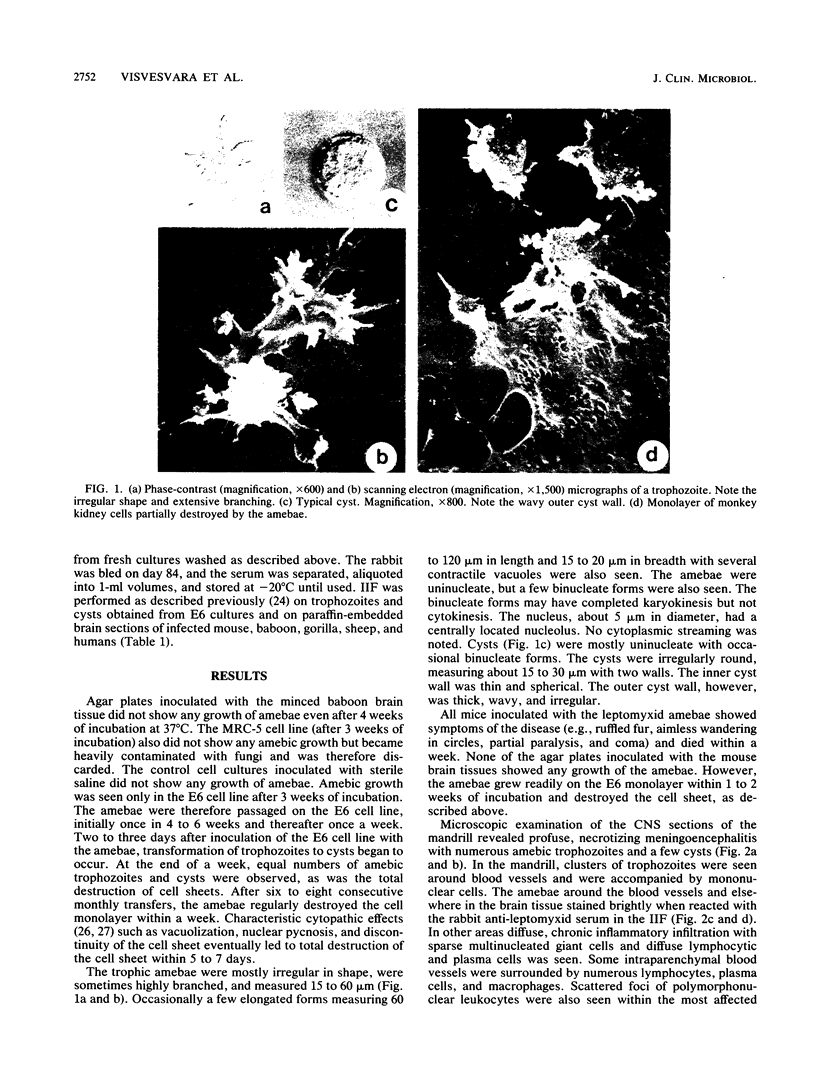
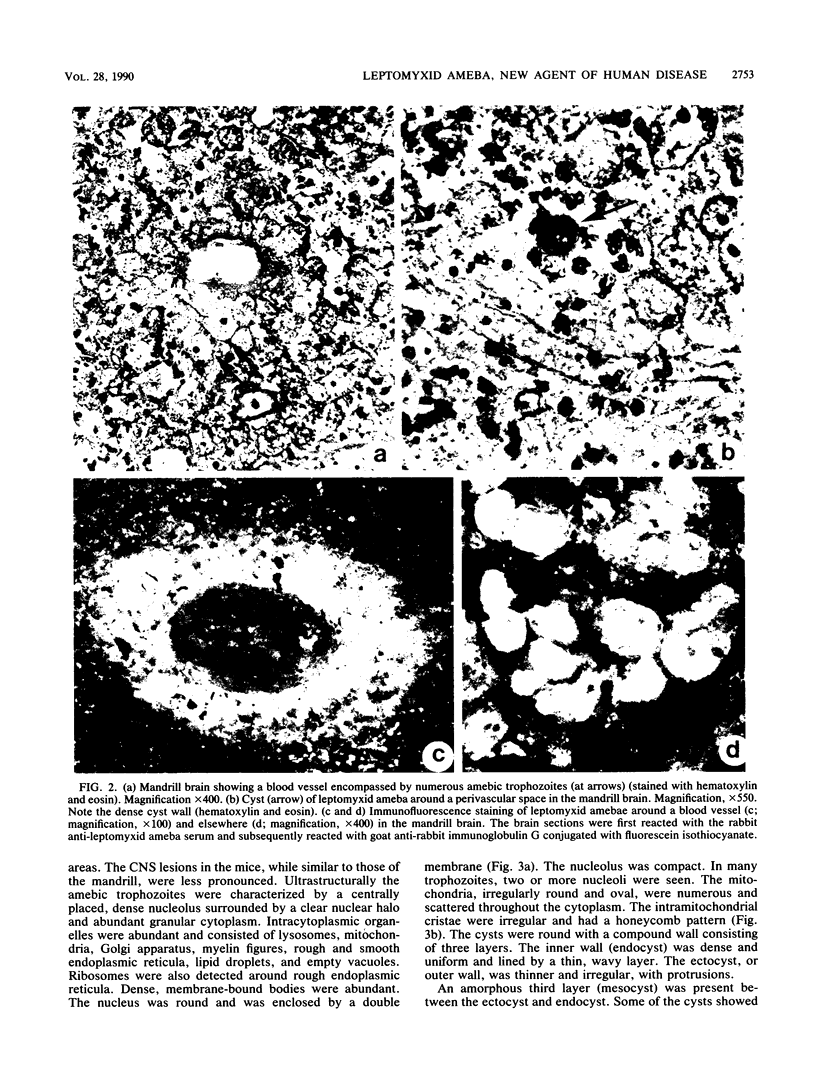
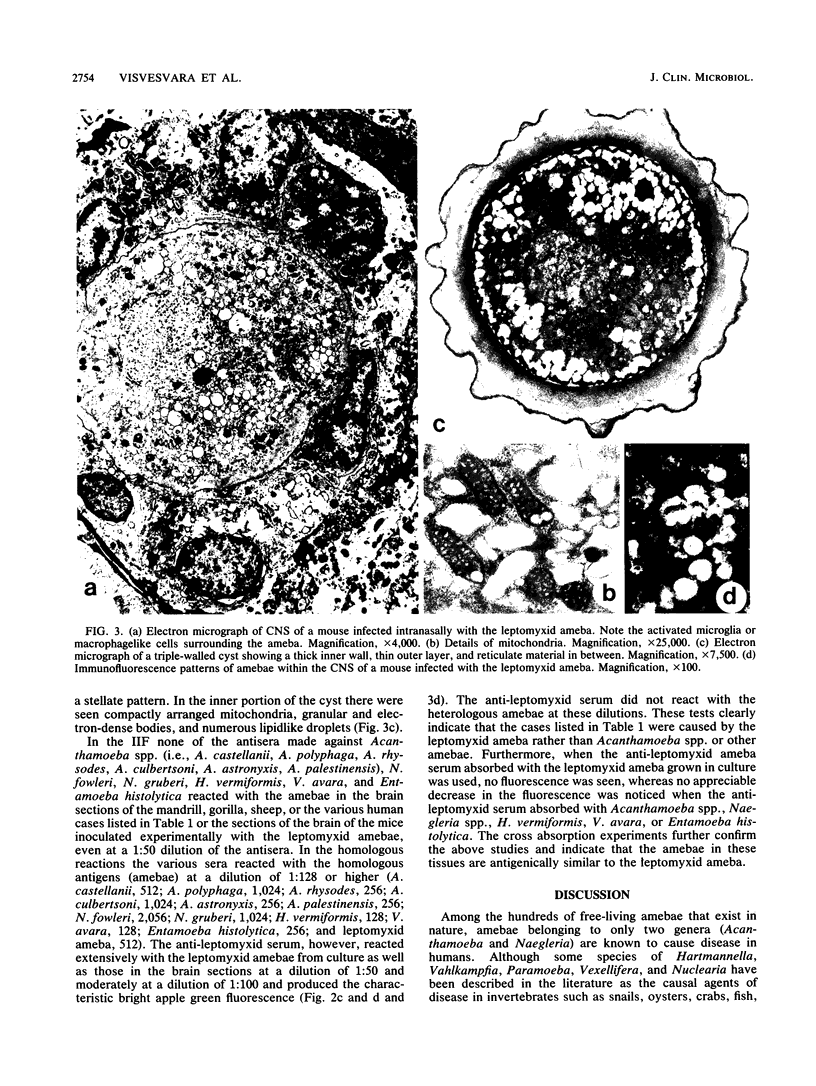
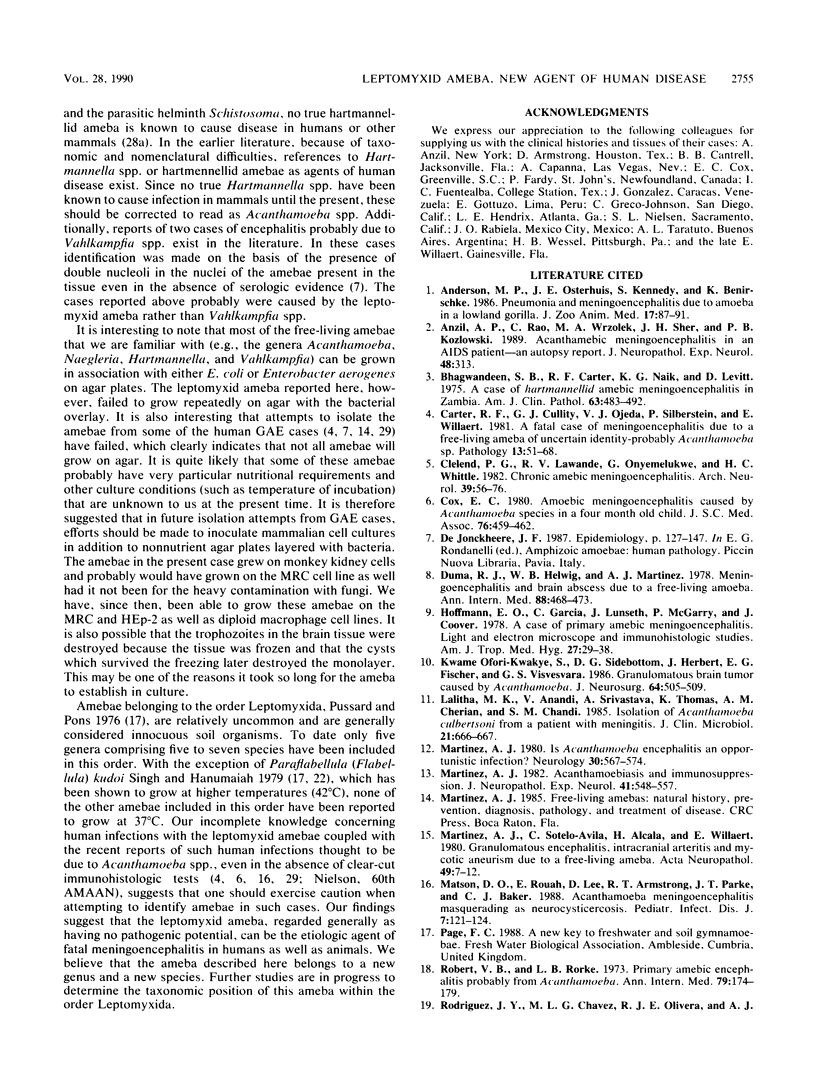
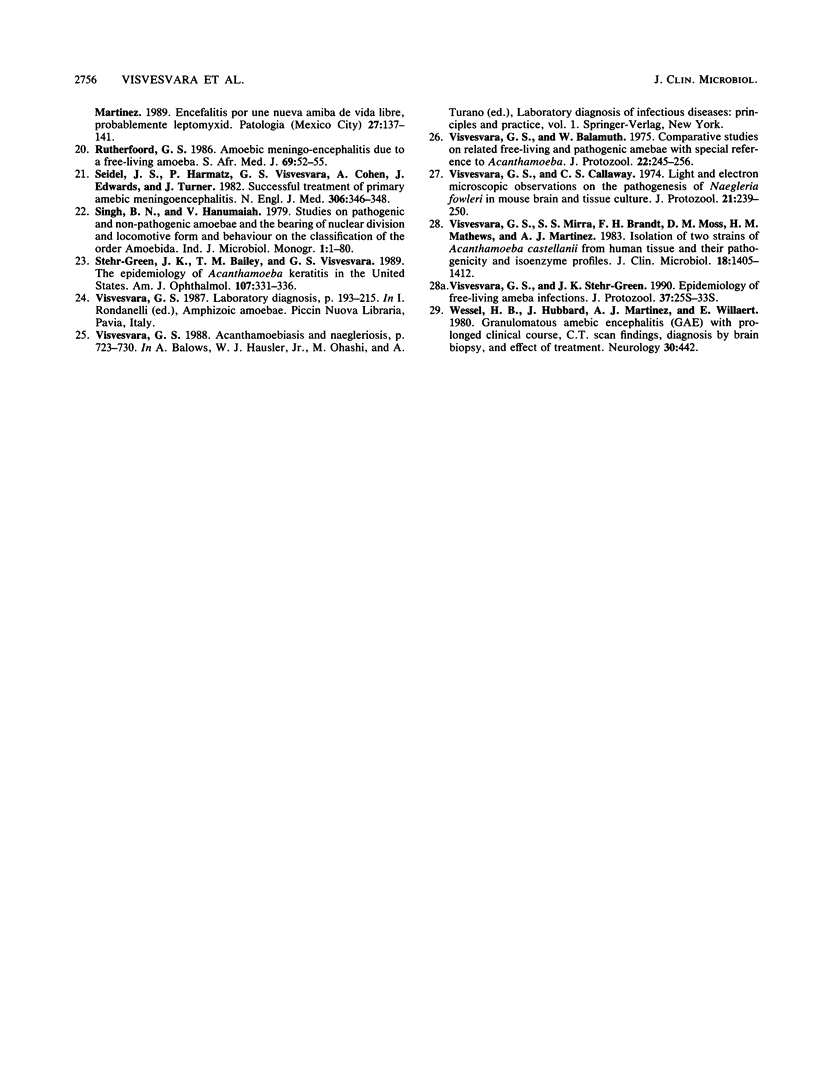
Images in this article
Selected References
These references are in PubMed. This may not be the complete list of references from this article.
- Bhagwandeen S. B., Carter R. F., Naik K. G., Levitt D. A case of hartmannellid amebic meningoencephalitis in Zambia. Am J Clin Pathol. 1975 Apr;63(4):483–492. doi: 10.1093/ajcp/63.4.483. [DOI] [PubMed] [Google Scholar]
- Carter R. F., Cullity G. J., Ojeda V. J., Silberstein P., Willaert E. A fatal case of meningoencephalitis due to a free-living amoeba of uncertain identity--probably acanthamoeba sp. Pathology. 1981 Jan;13(1):51–68. doi: 10.3109/00313028109086829. [DOI] [PubMed] [Google Scholar]
- Cleland P. G., Lawande R. V., Onyemelukwe G., Whittle H. C. Chronic amebic meningoencephalitis. Arch Neurol. 1982 Jan;39(1):56–57. doi: 10.1001/archneur.1982.00510130058016. [DOI] [PubMed] [Google Scholar]
- Cox E. C. Amebic meningoencephalitis caused by Acanthamoeba species in a four month old child. J S C Med Assoc. 1980 Oct;76(10):459–462. [PubMed] [Google Scholar]
- Duma R. J., Helwig W. B., Martinez A. J. Meningoencephalitis and brain abscess due to a free-living amoeba. Ann Intern Med. 1978 Apr;88(4):468–473. doi: 10.7326/0003-4819-88-4-468. [DOI] [PubMed] [Google Scholar]
- Hoffmann E. O., Garcia C., Lunseth J., McGarry P., Coover J. A case of primary amebic meningoencephalitis. Light and electron microscopy, and immunohistologic studies. Am J Trop Med Hyg. 1978 Jan;27(1 Pt 1):29–38. doi: 10.4269/ajtmh.1978.27.29. [DOI] [PubMed] [Google Scholar]
- Lalitha M. K., Anandi V., Srivastava A., Thomas K., Cherian A. M., Chandi S. M. Isolation of Acanthamoeba culbertsoni from a patient with meningitis. J Clin Microbiol. 1985 Apr;21(4):666–667. doi: 10.1128/jcm.21.4.666-667.1985. [DOI] [PMC free article] [PubMed] [Google Scholar]
- Martinez A. J. Acanthamoebiasis and immunosuppression. Case report. J Neuropathol Exp Neurol. 1982 Sep;41(5):548–557. doi: 10.1097/00005072-198209000-00007. [DOI] [PubMed] [Google Scholar]
- Martínez A. J. Is Acanthamoeba encephalitis an opportunistic infection? Neurology. 1980 Jun;30(6):567–574. doi: 10.1212/wnl.30.6.567. [DOI] [PubMed] [Google Scholar]
- Martínez A. J., Sotelo-Avila C., Alcalá H., Willaert E. Granulomatous encephalitis, intracranial arteritis, and mycotic aneurysm due to a free-living ameba. Acta Neuropathol. 1980;49(1):7–12. doi: 10.1007/BF00692213. [DOI] [PubMed] [Google Scholar]
- Matson D. O., Rouah E., Lee R. T., Armstrong D., Parke J. T., Baker C. J. Acanthameba meningoencephalitis masquerading as neurocysticercosis. Pediatr Infect Dis J. 1988 Feb;7(2):121–124. doi: 10.1097/00006454-198802000-00011. [DOI] [PubMed] [Google Scholar]
- Ofori-Kwakye S. K., Sidebottom D. G., Herbert J., Fischer E. G., Visvesvara G. S. Granulomatous brain tumor caused by Acanthamoeba. Case report. J Neurosurg. 1986 Mar;64(3):505–509. doi: 10.3171/jns.1986.64.3.0505. [DOI] [PubMed] [Google Scholar]
- Robert V. B., Rorke L. B. Primary amebic encephalitis, probably from Acanthamoeba. Ann Intern Med. 1973 Aug;79(2):174–179. doi: 10.7326/0003-4819-79-2-174. [DOI] [PubMed] [Google Scholar]
- Rutherfoord G. S. Amoebic meningo-encephalitis due to a free-living amoeba. A case report. S Afr Med J. 1986 Jan 4;69(1):52–55. [PubMed] [Google Scholar]
- Seidel J. S., Harmatz P., Visvesvara G. S., Cohen A., Edwards J., Turner J. Successful treatment of primary amebic meningoencephalitis. N Engl J Med. 1982 Feb 11;306(6):346–348. doi: 10.1056/NEJM198202113060607. [DOI] [PubMed] [Google Scholar]
- Stehr-Green J. K., Bailey T. M., Visvesvara G. S. The epidemiology of Acanthamoeba keratitis in the United States. Am J Ophthalmol. 1989 Apr 15;107(4):331–336. doi: 10.1016/0002-9394(89)90654-5. [DOI] [PubMed] [Google Scholar]
- Visvesvara G. S., Balamuth W. Comparative studies on related free-living and pathogenic amebae with special reference to Acanthamoeba. J Protozool. 1975 May;22(2):245–256. doi: 10.1111/j.1550-7408.1975.tb05860.x. [DOI] [PubMed] [Google Scholar]
- Visvesvara G. S., Callaway C. S. Light and electron microsopic observations on the pathogenesis of Naegleria fowleri in mouse brain and tissue culture. J Protozool. 1974 May;21(2):239–250. doi: 10.1111/j.1550-7408.1974.tb03648.x. [DOI] [PubMed] [Google Scholar]
- Visvesvara G. S., Mirra S. S., Brandt F. H., Moss D. M., Mathews H. M., Martinez A. J. Isolation of two strains of Acanthamoeba castellanii from human tissue and their pathogenicity and isoenzyme profiles. J Clin Microbiol. 1983 Dec;18(6):1405–1412. doi: 10.1128/jcm.18.6.1405-1412.1983. [DOI] [PMC free article] [PubMed] [Google Scholar]
- Visvesvara G. S., Stehr-Green J. K. Epidemiology of free-living ameba infections. J Protozool. 1990 Jul-Aug;37(4):25S–33S. doi: 10.1111/j.1550-7408.1990.tb01142.x. [DOI] [PubMed] [Google Scholar]





